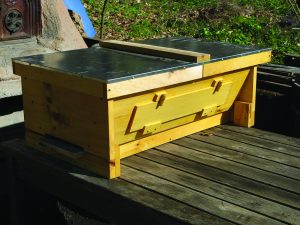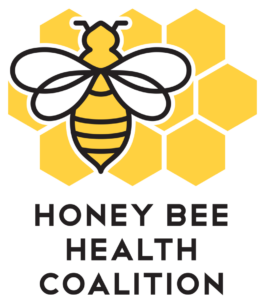By: Ross Conrad
When is the best time to harvest honey from the hive? . . . It’s a question that crosses the mind of most every beekeeper eventually. As with many beekeeping questions, the answer is “it depends.”
The honey bee is one of the only creatures on earth, other than humans, that will take more than they need from the environment around them. This is due to their powerful hoarding instinct. As long as there is room in the hive to store nectar and ripen it into honey, and there are nectar sources accessible due to favorable weather, a hive of bees will keep collecting nectar and storing it in the hive as honey even though they may already have far more honey stored than is necessary in order to survive a long cold Winter.

The Spikenard Top Bar Hive is billed as the first
commercial top bar hive to include a Varroa screen and accommodate 10-frame standard supers. A portion of the proceeds from all sales go to supportingGunther Hauk’s honey bee sanctuary at Spikenard Farm in Virginia.
Beekeepers take advantage of this hoarding instinct by increasing the capacity of the hive to hold honey whenever the combs in the hive are close to being fully utilized by adding another honey super to our Langstroth hives or additional frames to the top bar hives. Some beekeepers have even designed top bar hives so that standard Langstroth style honey supers with frames can be added on top after all the top bars have been filled below (see photo).
There are numerous factors that go into the decision when to harvest honey from hives. To begin with, one must be patient. The bees must be given adequate time to collect nectar and process it into honey by reducing the moisture content of the nectar below about 18%. Rush the process and harvest before it is fully ripened by the bees and you may end up with fermented honey. Not the end of the world since it is still edible and makes great mead, but if high quality honey that stores well or is for sale is your goal, low moisture is what you want. A good rule of thumb is to not extract unless at least 75% of the cells in the honey combs are capped. By extracting one uncapped honey frame for every three capped frames of honey, the overall moisture content will tend to be below the level where fermentation will occur.
The other extreme is to wait until all the blossoming plants have finished blooming in order to maximize the honey crop by harvesting as late in the season as possible. Unfortunately, in the Northeast the last of the major nectar flows ends in late September when temperatures typically are getting quite chilly at night. The cold temperatures make honey in the combs thick and much more difficult to extract. Robbing pressure is also very strong at this time of year. With no other sources of nectar to forage on and Winter right around the corner, honey supers must be kept covered and protected from marauding bees as they are being taken off hives. The extra effort involved in defending your crop from robbing bees greatly reduces the joy of the honey harvest.
Another reason why it is not usually preferable to put off the honey harvest until late in the season is because some of the treatments used for pests and diseases are temperature sensitive. Wait too long and average daytime temperatures may not be favorable for effective treatments.
Since most pest and disease treatments should not be used when honey supers to be harvested are on the hive due to contamination concerns, all harvesting may need to be completed before any treatments can begin. Given the importance of “taking care of the bees that will raise the bees that will live through the winter” (to paraphrase Bee Culture editor Kim Flottum) treatments for Varroa and disease must take place early enough to ensure healthy Winter bees. As a result, the temperature requirements of treatments may serve to dictate when the honey harvest should happen.
When a colony has stored far more honey than they can reasonably be expected to consume during a long Winter, I believe it is best to harvest the excess rather than leave it on the hive for the Winter. While some well-meaning beekeepers will wait to harvest their honey in Spring rather than Autumn in an effort to be sure the bees have enough honey for Winter, there are a number of reasons why I don’t believe this is a good idea.

Harvest honey too late in the season and the honey in the comb may become crystalized, making it difficult to remove from the comb.
Winter honey that does not get used and is still in the hive come spring will often become crystallized (at least in the Northeast). Thus, each Spring the bees can be seen uncapping honey that was unused during the Winter and sucking up what little liquid remains of the honey, while the numerous sugar crystals will be found on the bottom board or on the ground as they are removed from the hive as debris by the bees. In addition, crystalized honey is hard to extract. This makes life for the beekeeper much more difficult both due to the longer time it takes to extract crystalized honey and the extra wear and tear on the extracting equipment. It also increases the potential for comb blowouts during the extracting process and additional energy will be required to run the extractor since the crystalized honey will require it to run for a longer period of time.
The combs holding the honey left over in spring may also become moldy depending on weather conditions and the strength of the colony, and this may impact the quality of the honey harvested. In addition, leaving more space on the hive than necessary (in the form of extra honey supers that the bees don’t need), which must be maintained and patrolled by the colony is usually a bad idea during these days of weak hives, small hive beetles, wax moths, etc.

The Bee Escape Board which acts as a one-way door to remove bees from supers, works best when the honey harvest is timed to occur when days are warm and nights are on the cool side. Cool nights provide bees with an extra incentive to leave the honey supers when they pass through the Bee Escape on their way to help warm the brood nest.
Perhaps the most important reason why I don’t like the idea of waiting to harvest honey from hives until Spring is because the bees may need any honey that is found left over in the hive in Spring to get themselves ready for the upcoming Winter. Life for the honey bee in the Northeast is primarily about reproducing and surviving Winter. Although colonies of bees may historically build up and store enough honey for Winter in your location, what if this is the year that a drought or some other weather abnormality prevents the bees from storing enough honey to survive the coming Winter? Any honey left over from the previous Winter and found in the hive in
Spring may just be what is needed to ensure the colony will be well provisioned for next Winter. At minimum, it can help reduce the amount of feeding that may be required by the beekeeper during Winter preparations. Since I can’t predict the weather and know with any certainty what the season will be like, I prefer to only harvest all excess honey in late Summer here in Vermont. This is because this is the only time of year when I can be pretty sure just how much honey the colony is likely to have going into Winter and I am able to determine if the amount of honey in the hive is going to be enough for the colony to survive the cold season dearth.
There are a few exceptions to the general rule of a single late summer harvest that must be acknowledged. For example, a beekeeper that wants to offer honey varietals in order to serve novelty markets or to compete with other beekeepers by specializing their product line will have to take the risk that the honey varietals that are harvested in Spring or early Summer will not be needed in order for the colony to get through Winter. Sure, such a situation may be remedied by feeding sugar syrup to the bees later in the season, but given the mounting evidence that indicates that bees are much healthier when raised and maintained on natural honey and pollen rather than substitutes, the wisdom of harvesting early and potentially leaving the hive short on naturally derived food stores becomes questionable.
Another potential reason a beekeeper may decide to harvest honey before late Summer or early Autumn in the Northeast is due to poor planning (or limited finances) that results in the beekeeper not having enough equipment to super hives in a timely manner and take advantage of the area’s major nectar flows. Full supers of honey can be harvested, quickly extracted and put back on hives to fill up again, making up for the lack of extra honey supers. Such a scenario is a lot more work than simply harvesting all at once at the end of the season, but on some occasions this may be the best that one can do.
Whenever one chooses to harvest their honey, it is critical these days that the harvest is timed so that extracting can be done within two-to-three days of removing the bees from the frames of honey and taking the honey from the hive. The sooner extracting and processing takes place after harvesting the better in order to prevent wax moths, or small hive beetles from getting established on the unprotected combs and ruining all the hard work done by both bee and beekeeper.
The honey harvest is often one of the most enjoyable and rewarding parts of keeping bees. In a sense it is the culmination of all the hard work that has come before. When timed correctly, it can go fairly smoothly and efficiently while at the same time helping to set the colony up for a successful Winter and high productivity in the following season. May your harvest be fruitful and timely this year.
Ross Conrad is the author of Natural Beekeeping 2nd Edition published 2013 by Chelsea Green Publishers.









